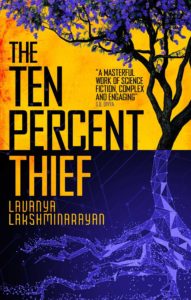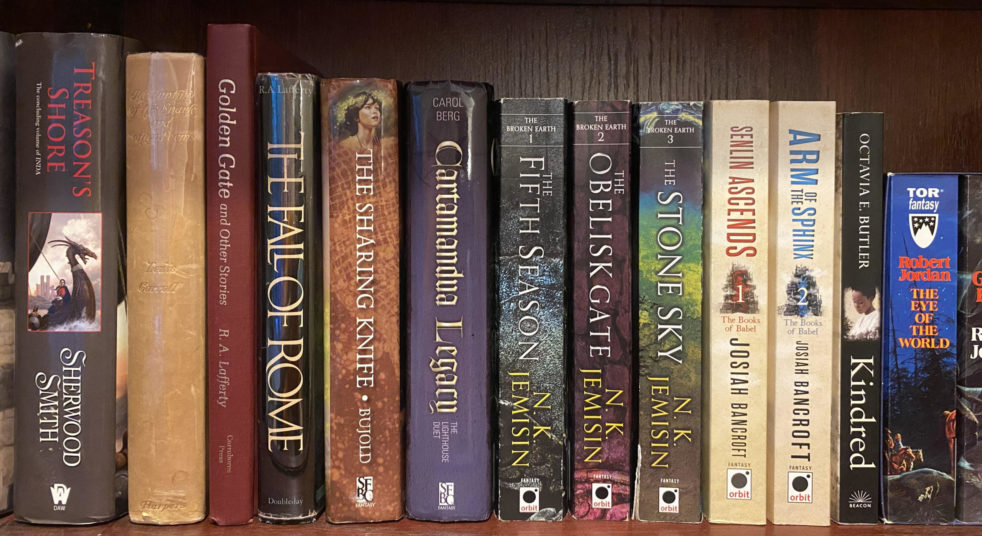
This review is based on an eARC (Advance Reading Copy) provided by the publisher via NetGalley in exchange for an honest review. The Ten Percent Thief will be released on March 28, 2023.
I’ve had Lavanya Lakshminarayan’s Analog/Virtual on my TBR for a couple years, after seeing it recommended on a list of underrated speculative fiction from outside the US, UK, and Canada. But between prices being higher than domestic work and the lack of social media chatter, I never quite managed to move it to the top. So when I saw it was being released in the US under a new title, I knew I had the perfect chance to check out The Ten Percent Thief.
The Ten Percent Thief is a mosaic novel taking place in the dystopian successor of Bangalore, following its purchase by a meritocratic tech company and rebranding as Apex City. The twenty different chapters feature about that many perspective characters, although central figures from one chapter regularly make cameos in subsequent ones. There is a sense of progression from start-to-finish—primarily in the development of revolutionary activity among the “Analogs” at the bottom ten-percent of society who have been banned from making use of Apex City’s technology—but the novel is as much dystopian slice-of-life as it is anything else.
While The Ten Percent Thief may not have a driving plot or a small cast to focus the story, it offers plenty for fans of stories driven by theme or world. It’s no hard sci-fi dystopia—the tech is so advanced it may as well be magic, and little time is spent exploring its limitations—but it’s dedicated to showing every corner of Apex City and how the techno-meritocracy affects the lives of people from every social class. Perhaps it’s an exaggerated picture, but it’s not too many steps past plausible, with sharp satire of the horrifyingly calcified inequality forming in direct consequence to surface-level meritocratic societal organization.
The social prejudice and legal obstacles barring Analog advancement are perhaps the longest-running theme, but the course of the story sees it touch on censorship, groupthink, pregnancy discrimination, environmental myopia, social anxiety, and more. There’s a lot here, and none of it feels forced—every bit follows neatly from the organizing principles of society.
Different parts of the novel approach the themes in different ways, and I would group them into three general categories: Analog stories, character-focused Virtual slice-of-life, and zoomed-out Virtual society pieces. Personally, I found the Virtual slice-of-life chapters to be far-and-away the most effective. Lakshminarayan delivers heart-wrenchingly intimate portraits of Virtuals terrified of losing their place in society—or of trying to climb to the next rung on the societal ladder—that lay bare the world’s horrors while simultaneously generating a remarkable emotional attachment to relatively privileged figures only glimpsed for the space of a chapter. A novella with just these chapters, even without the connective tissue from the rest of the book, would be a must-read.
The connective tissue, on the other hand, is merely adequate. The Analogs are planning Revolution, and we see plenty of steps along the way, not shying back from even the most callous and cynical moments. It’s a fine story, but not particularly remarkable–I’m not at all convinced that the Virtual chapters don’t do a better job explaining the Analog world than the Analog chapters do.
Finally, there are the wide-lens Virtual society chapters, which get more frequent in the second half of the novel. These hit their themes hard, with more than a few moments of morbid hilarity. But they lack the pathos of the slice-of-life chapters, which can make it difficult to cut through the dizzying jargon to focus on the story itself. And because they don’t limit themselves to one perspective, the actions can sometimes feel disconnected, with the inner monologue cut away and the key developments viewed only from the perspectives of side characters. Furthermore, the zoomed-out view of society leads to more emphasis on the technology than on more personal interactions, prompting questions about Apex City’s technical limitations that the novel doesn’t seem especially interested in answering. Don’t get me wrong—these sections are plenty readable and certainly have their own virtues, they’re simply more uneven and not quite as powerful as the slice-of-life chapters.
All told, it’s a novel that’s absolutely worth your while, even if it has its ups and downs. The worldbuilding is more interested in the personal fallout than the tech details, but it delivers a chilling and often all-too-plausible portrait of a city that values production to such an extent that it organizes its whole society around staying out of the bottom 10%. There’s enough overarching plot for readers who want to feel something has changed over the course of the book, but this is not a plotty book. It’s the intimate, slice-of-life sections that really shine and are worth the price of admission all on their own. Not every chapter is a wild success, but there’s more good than mediocre and very little bad.
Recommended if you like: theme-heavy books, dystopias, slice-of-life.
Can I use it for Bingo? It’s hard mode for Standalone, Revolutions and Rebellions, and Features Mental Health, but it also has a BIPOC Author, Family Matters, and there are a handful of Antiheroes if you don’t mind not having one central protagonist.
Overall rating: 16 of Tar Vol’s 20. Four stars on Goodreads.
